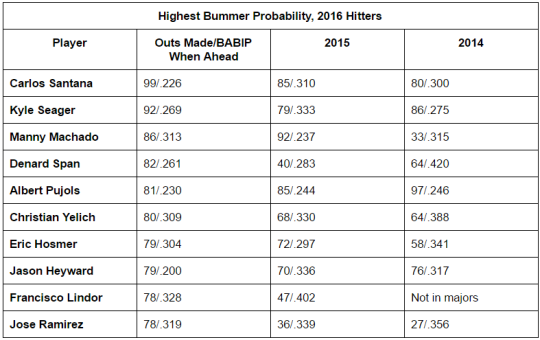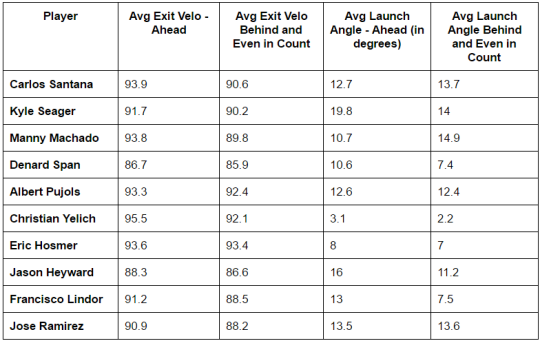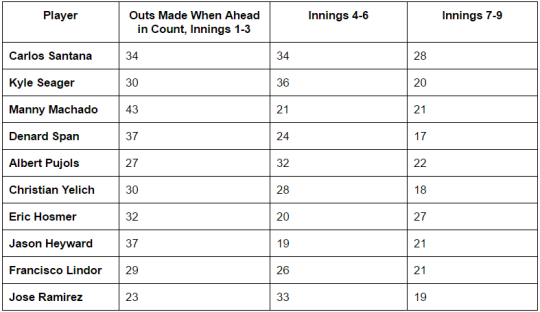Hitters Who Made the Most Outs When Ahead in the Count
Last week I explored how exciting it is when certain things happen in baseball that shouldn’t. Some of the moments are quirky, like Ben Revere homers, while some of them are static shocks of excitement, like a guy getting on despite being behind in the count. They’re all enjoyable though.
But let’s be fair. Sometimes hitters are up at the plate with the advantage. They’re ahead in the count, have the pitcher behind the 8-ball and the defense extra up on its toes, but then…womp womp. They strike out, hit a weak fly ball, or tap a grounder to short, and the at-bat ends with the curt sound of a deflating balloon. And we’d be remiss to not acknowledge the guys who left us deflated most in 2016.

Like last time, that’s the top 10 from last year, plus their previous two years for some context. This list is just as interesting because it’s just as diverse in terms of position, age, and spot in the lineup. Certain guys do stick out though. You can’t help but think how the consistency in the numbers for Albert Pujols could speak to his decline. From 2008-10, which are the first three years of data available from Statcast, his BABIP when ahead was .389, .313, and .288. Those are also the last three years his batting average was .300 or better, which is understandable if you consider the possibility that pitchers have become less fearful of him when they give him advantageous counts.
Then there’s the Curious Case in the Collapse of Jason Heyward. Nobody expected him to be so bad so quickly in his first year with the Cubs. How much of it had to do with his BABIP loafing on the Mendoza line when ahead? As such an aberration, does it suggest he could bounce back with anything more than terrible luck? Probably at least a little.
And let’s not forget Francisco Lindor! He’s the only guy to show up on this list and the best-when-behind list. Perhaps that speaks to his relative youth — maybe too much comfort when ahead and focus that wants to make up for it when behind. That will be interesting to track as he moves into the next phase of his career.

Collectively, these guys were all more comfortable when ahead, as you may have guessed. Pujols sticks out again in terms of how the ball comes off his bat. While he’s been making outs at a high rate when ahead the last three years, he’s also still squaring up the ball pretty darn well. As for Heyward, his launch angle when ahead might be another reason he could improve in 2017, even if his exit velo is almost definitively average. Unless his combo of loft and soft-ish hitting gives defenders enough time to get to the ball. Then maybe he’s doomed forever.
Kyle Seager has the highest launch angle when ahead and second-highest in other counts. While he clearly likes to put the ball in the air, his decent-but-not-exceptional exit velo might make for a lot of long outs. And at the other end of the spectrum, Christian Yelich’s numbers tell us he’s hitting it low and hard a ton. That makes it easier to grasp why he made 80 outs when ahead in the count last year, but he also more than doubled his career home-run total last year, so he’s starting to put some loft under the ball.
Based on the numbers immediately above, Carlos Santana might get on base even more in the coming season. Hitting it as hard and at the angles he did in 2016 makes it seem unreasonable that he made the most outs in the league when ahead.
And finally, we examine when these guys made their outs when in hitters counts. Like the best-when-behind list possibly provided some inkling when to tune into a game or one of those players’ at-bats, this data might tell you when to tune out. Unless you’re into disappointment or schadenfreude.

Only two guys made more outs in the last three innings than they did in the first or middle three: Eric Hosmer and Jason Heyward. It’s intriguing that everyone else trended down as the game went on. I don’t readily buy into the idea of players being “in the zone” or “a great place mentally.” However, I am curious about the possibility of mentality making an impact on action in this context because I do believe mind and body are one. That they might come together as the stakes get higher would speak to the crux of how any of these hitters have become professionals.
I don’t think these numbers are as informative in the players’ approaches when ahead as much as they are a matter of BABIP. And by no means do I think that’s bulletproof. They still tell us how they hit the ball and when, which means they leave open opportunities to examine where tweaks might occur, though. With the variability of average on balls in play, it’s unlikely these players post the exact same numbers, but if any of them come close, it could account for roughly 20% of the total outs they make all year. Or 20% of the reasons you see what other games are on.
Tim Jackson is a writer and educator who loves pitching duels. Find him and all his baseball thoughts online at timjacksonwrites.com/baseball and @TimCertain.